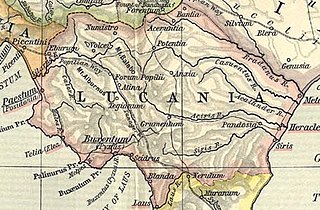
Lucania was a historical region of Southern Italy, corresponding to the modern-day region of Basilicata. It was the land of the Lucani, an Oscan people. It extended from the Tyrrhenian Sea to the Gulf of Taranto. It bordered with Samnium and Campania in the north, Apulia in the east, and Bruttium in the south-west, and was at the tip of the peninsula which is now called Calabria. It comprised almost all the modern region of Basilicata, the southern part of the Province of Salerno and a northern portion of the Province of Cosenza.

Paestum was a major ancient Greek city on the coast of the Tyrrhenian Sea, in Magna Graecia. The ruins of Paestum are famous for their three ancient Greek temples in the Doric order dating from about 550 to 450 BC that are in an excellent state of preservation. The city walls and amphitheatre are largely intact, and the bottom of the walls of many other structures remain, as well as paved roads. The site is open to the public, and there is a modern national museum within it, which also contains the finds from the associated Greek site of Foce del Sele.

The province of Salerno is a province in the Campania region of Italy.

Agropoli is a town and comune located in the Cilento area of the province of Salerno, Campania, Italy. It is situated at the start of the Cilentan Coast, on the Tyrrhenian Sea.

Eboli is a town and comune of Campania, southern Italy, in the province of Salerno.
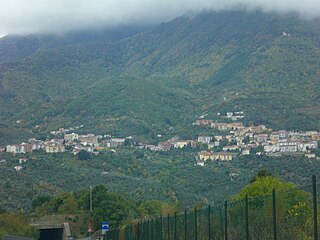
Calabritto is an Italian town and a commune in the province of Avellino, Campania, Italy. It occupies a hilly-mountainous area at the eastern tip of the Monti Picentini range, in the upper Sele valley.
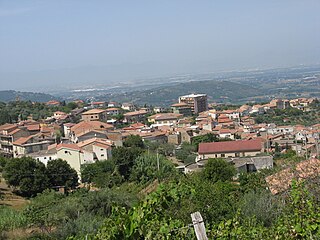
Albanella is a town and comune in the province of Salerno in the Campania region of south-western Italy. It is located 51 kilometers from the city of Salerno.

Battipaglia is a municipality (comune) in the province of Salerno, Campania, south-western Italy.

Capaccio Paestum is a town and comune in the province of Salerno in the Campania region of south-western Italy. The ruins of the ancient Greek city of Paestum lie within borders of the comune.

Giungano is a town and comune in the province of Salerno in the Campania region of south-western Italy.
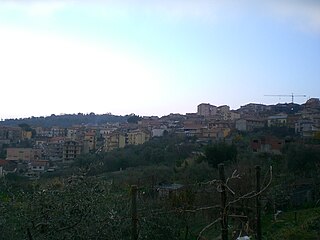
Serre is a town and comune in the province of Salerno in the Campania region of south-western Italy.
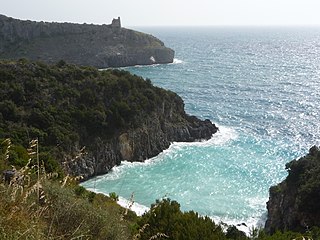
Cilento is an Italian geographical region of Campania in the central and southern part of the province of Salerno and an important tourist area of southern Italy.

Cilento, Vallo di Diano and Alburni National Park is an Italian national park in the Province of Salerno, in Campania in southern Italy. It includes much of the Cilento, the Vallo di Diano and the Monti Alburni. It was founded in 1991, and was formerly known as the Parco Nazionale del Cilento e Vallo di Diano.
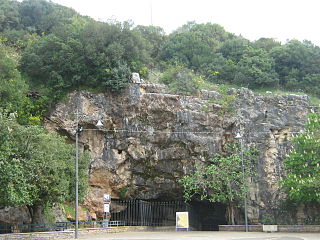
The Castelcivita Caves are a karst cave system located in the municipality of Castelcivita, in the province of Salerno, Campania, southern Italy.

The Gaudo Culture is an Eneolithic culture from Southern Italy, primarily in the region of Campania, active at the end of the 4th millennium BC, whose typesite necropolis is located near Paestum, not far from the mouth of the river Sele. Its name comes from the Spina-Gaudo necropolis.

Materdomini is an Italian hamlet (frazione) situated in the municipality of Caposele, Province of Avellino, Campania. As of 2009 its population was of 735.
Paestum is a frazione of the comune (municipality) of Capaccio in the Cilento area of southern Italy. It lies in the province of Salerno which is part of the region of Campania. It is situated on the Tyrrhenian coast and is notable for the famous ruins of the ancient city of the same name nearby.

The Heraion at Foce del Sele is an archaeological site consisting of an Ancient Greek sanctuary complex dedicated to the goddess Hera in what was Magna Graecia. When built, the complex was located at the mouth of the Sele, approximately 8 km (5.0 mi) north of the Greek city of Poseidonia that was famous for its three standing Greek temples. Due to the deposition of alluvial sediment by the river, the site now is approximately 2.3 km (1.4 mi) from the modern coast.
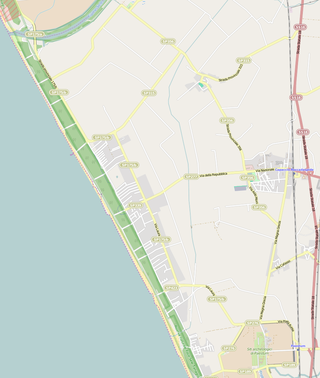
Laura is a southern Italian village and hamlet (frazione) of Capaccio, a municipality in the province of Salerno, Campania. As of 2001 its population was of 1,301.

The strada statale 18 "Tirrena Inferiore" is an Italian state road, connecting Campania and Calabria. It is among the longest and most important state highways in southern Italy, considering that it follows the Tyrrhenian coast, from Salerno to Reggio di Calabria.




















